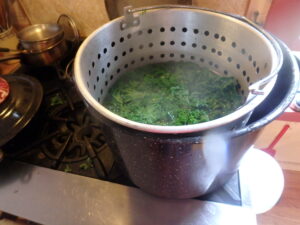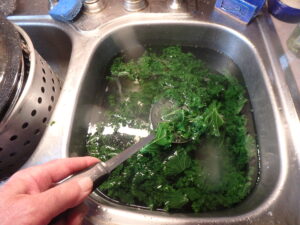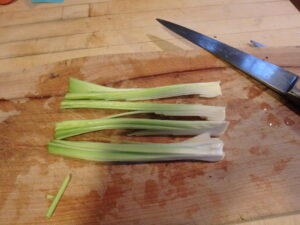Getting Ready for Winter
Posted on Tuesday, September 8, 2020 · Leave a Comment
Like a conscientious squirrel, I put away food for the winter in August and September. I freeze and dehydrate lots of vegetables, and store some in my cool basement. Here are some tips on ways to save food for later.
I grew about a dozen kale plants this year. The workhorse are those that end in “bor” – winterbor, redbor, starbor and others. I get seeds from Johnny’s Selected Seeds of Maine to start my own indoors in the spring, or find them at my local garden center growing in 6-packs. Most of the kale I grow is for winter use because it freezes so well. This week I put up 8 quart freezer bags of kale, and I still have more I may process later.
To freeze kale I wash it first and make sure it is free of (Ugh) slugs and bugs. Then I either pull the leaves off the midrib, or slice it off. I chop the kale into 1-or 2-inch squares, prior to blanching in boiling water.

Blanching kale is worth the work
To blanch the kale I submerse it in boiling water for 30 to 60 seconds. This will kill the “aging” enzymes in kale, allowing me to keep it frozen and good to eat practically forever, if need be. Normally I eat all the kale within a year of freezing it, which is recommended. I could freeze kale without blanching it if I were planning on eating it all in 3 months or so. But blanching also allows me to pack more kale in each bag.
For the blanching of kale and other veggies, I use my big black tin pot that is sold for hot water bath canning – it is roughly 14 inches wide and 9 inches deep, and will hold 7 quart mason jars for canning tomatoes. I fill the canner half full, and bring to a full, rolling boil.
I have a special blanching pot that fits inside it – a metal pot with big holes in the bottom and sides, and handle for putting it inside my canning pot, and taking it out. You can buy a canner at any hardware store, but the inserts are harder to find – a restaurant supply stores should have them.
Then I drop in the kale– I do 15 leaves or so at a time. The water will just barely come to a re-boil in 60 seconds. Use a timer. If you use lots of water and not too many leaves, you can blanch for just 30 seconds.

Cold water cools the kale and stops the cooking
Next you want to cool the kale quickly. Some people prepare an ice bath, but I just fill the kitchen sink with cold tap water. I lift the blanching pot and let the water drain back into the canner. Then, with the lid of the canner under the pot, I move from stove to sink, and drop the kale into the cold water. I stir, then scoop it out with a colander or slotted spoon, and put it into my salad spinner. The brand I prefer is Zylis, which has a pull string, not a crank. Sometimes I squeeze the kale to get some of the water out before spinning it.
Lastly, I dump the damp kale out of the salad spinner and onto a clean dish towel on the countertop. I pat it and roll it in the towel to remove more moisture. I fill bags, squeeze out some air, and then suck out as much air as I can with a straw inserted into the bag when it is closed right up to the straw. Still sucking, I pull the straw and snap the zipper shut.
Other veggies I blanch include beans, beets, broccoli, Brussels sprouts, cabbage, carrots, cauliflower, corn, kale, peaches, spinach, and Swiss chard. But not all veggies need blanching. Things I don’t blanch include apples, berries, pears, peppers, leeks, and tomatoes. And I bake or steam winter squash, then freeze it.
Summer squash for use as a side dish needs only 30 seconds of blanching, but squash for soup I don’t blanch at all. This week I put up 11 quarts of grated Romanesco zucchini for use in soups. Even big Romanescos are good, if you remove the seeds. I use the grater blade on my food processor to grate it – it would take forever by hand. One bag of grated zucchini with an equal amount of tomato (which I freeze whole), some onions or frozen leeks, vegetable bouillon, and spices makes a great winter soup.

Leeks with leaves cut off and quartered before chopping and freezing
I grow a lot of leeks, in part because they freeze so well. I wash them, take off a layer or so of outer leaves, cut off the tops and quarter them lengthwise. I chop them, put them in freezer bags and suck out the air. They last forever in the freezer. I store lots of onions, but always run out before next year’s crop comes in. And onions don’t last forever, even in cool storage, so I use leeks in soups and stews when I run out of onions. I’ll put up a dozen quarts of leeks or more this year.
I haven’t harvested potatoes yet. I plant mine in June to avoid potato beetles. Didn’t have a single one this year! But it also means my potatoes are still growing now and are not ready to harvest. I have “stolen” a few by reaching under a plant and grabbing a few but not disrupting the others.
Potatoes store well in a spare fridge, or in a cement-block enclosure with a plywood lid in a cold space that stays in the 33- to 50-degree zone. Mice love them, so an old fridge really is best unless you are storing a lot of them. If I had to survive on what I grew, I’d grow a lot of potatoes and store them well.
So get to work. No point in growing a lot of produce and letting it go to waste. Of course, it’s fun to share with friends and the local food pantry.
Henry can be reached at
henry.homeyer@comcast.net or at PO Box 364, Cornish Flat, NH 03746. He is the author or 4 gardening books, and is a UNH Master Gardener.





